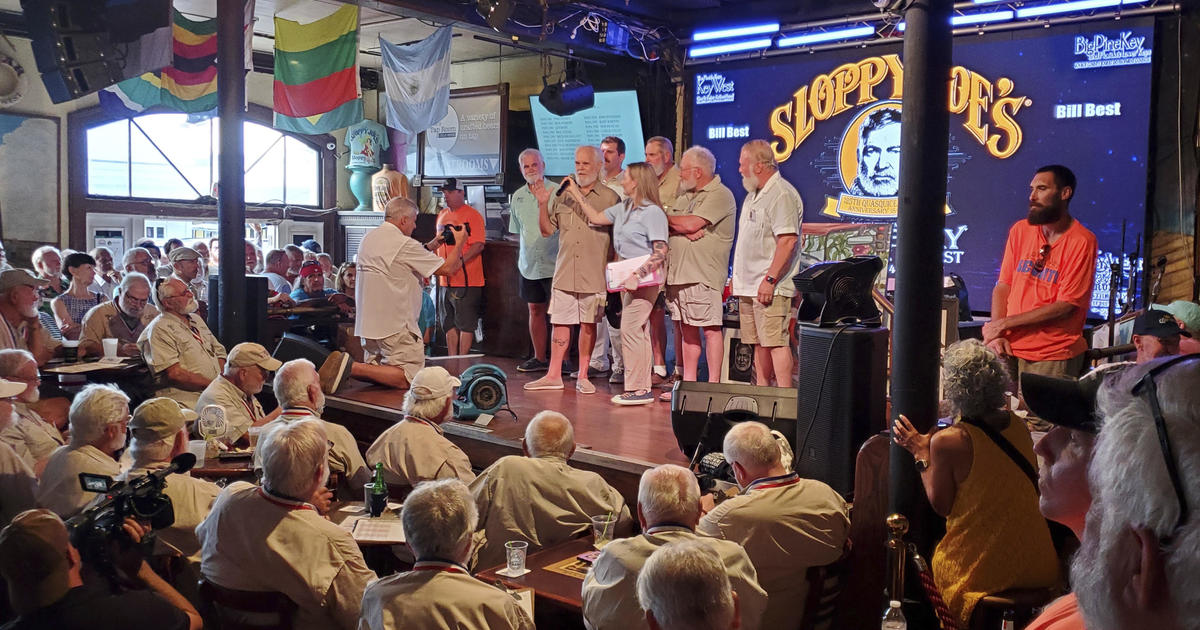Hemingway's Legacy Lives On in Key West

Ernest Hemingway's enduring legacy continues to draw fans, scholars and relatives to the island city of Key West, Florida, more than six decades after his death.
Hemingway spent the 1930s in Key West, embracing the island's unique lifestyle and finding inspiration for his award-winning novels. The annual Hemingway Days festival, which concluded this past Sunday, commemorated the 125th anniversary of his birth.
Hemingway's great-grandson, Stephen Hemingway Adams, grew up immersed in his ancestor's world. Through collaborations with his grandfather, Patrick Hemingway, Adams gained deeper insights into his famous relative.
"I got to work with my granddad, and we put out a book called 'Dear Papa,' which was all of the letters between Ernest and my grandfather," Adams said.
Hemingway's public image as a larger-than-life adventurer often overshadows his literary achievements. He was a serious artist, winning both the Pulitzer and Nobel Prizes, who infused his writing with his personal experiences. This blend of the man and the myth makes it difficult to fully separate the two.
Adams embraces this duality, finding it fascinating that some appreciate Hemingway more for his adventurous spirit than his writing. He sees the annual throngs of Hemingway look-alikes who visit Key West as a testament to this enduring fascination.
Key West was a far cry from the bustling tourist destination it is today when Hemingway first arrived in 1928. He and his second wife, Pauline, planned only a brief stop to pick up a car during their move from Paris to Arkansas. But their car wasn't ready, forcing them to wait for weeks.
Hemingway quickly integrated into the local community, forming friendships with business owners and fishermen. The couple eventually purchased a French Colonial home on a 1.5-acre lot in 1931, establishing a permanent base in the island.
Cori Convertito, a curator at the Key West Museum of Art & History, explains that Hemingway, contrary to the popular image of a reclusive writer, was a vibrant member of Key West society. He frequented local bars, fished with locals, and even participated in boxing matches.
Convertito highlights that Hemingway was in his 30s, not the white-bearded "Papa Hemingway" most look-alike contestants emulate, during his time in Key West. His fame skyrocketed after the success of "A Farewell to Arms," which he completed soon after arriving in Key West, and his coverage of the Spanish Civil War in the late 1930s.
Hemingway's passion for big-game fishing dominated his time in Key West. He acquired his own boat, the Pilar, in 1934, and pioneered new fishing techniques, driven by a desire to land a fully intact marlin. This pursuit mirrors the captivating story of the giant marlin caught in his 1952 novel, "The Old Man and the Sea."
Hemingway's commitment to quick fishing techniques made him an early member of the International Game Fish Association, where he was appointed vice president in 1940.
He also advocated for the Florida Keys and its residents, showcasing their struggles in his 1937 novel "To Have and Have Not," which is set in a Key West ravaged by the Great Depression.
Hemingway was a vocal critic of the government's inadequate response to the devastating 1935 Labor Day hurricane. He felt a strong connection to the victims, many of whom were World War I veterans hired for a federal jobs program to build the Overseas Highway. Hemingway, a veteran himself, joined the recovery efforts, using his boat to pull bodies from the ocean.
Michael Morawski, CEO of the Hemingway Home & Museum, credits Hemingway's great-aunt, Bernice Dixon, with preserving his legacy in Key West. She purchased his home in 1961, shortly after his death, and transformed it into a museum in 1964, eventually securing its status as a National Historic Landmark.
Beyond its historical and literary significance, the Hemingway Home & Museum is renowned for its resident polydactyl cats, known as Hemingway cats. About 60 cats with a genetic mutation for extra toes live on the estate, descendants of the original six-toed white cat gifted to Hemingway by a ship's captain.
The Hemingway Days festival began as a promotional stunt for Sloppy Joe's Bar, one of Hemingway's favorite haunts. Michael Whalton, a manager at the bar in 1980, envisioned the festival as a way to attract visitors during the island's slow season.
He launched the first Hemingway Days festival with a look-alike contest, short-story competition, and other activities surrounding Hemingway's birthday. The response surpassed expectations, with the festival evolving into a popular annual event that attracts visitors from around the world.
David Douglas, president of the Hemingway Look-Alike Society, has been a participant in the look-alike contest since 2000, winning in 2009. The organization has grown into a service organization with hundreds of members worldwide, raising over $350,000 in scholarships for Florida Keys students. They also sponsor a youth baseball team in Cuba, where Hemingway moved after leaving Florida.
Hemingway's impact on Key West goes beyond the literary realm. His love for the island, its people, and its way of life has left an enduring imprint that continues to attract visitors and inspire generations. His legacy, a blend of the legendary adventurer and the celebrated artist, lives on in the vibrant culture and spirit of Key West.





